Performance Monitoring of Mast-Mounted Cup Anemometers Multivariate Analysis with ROOT
Abstract
:1. Introduction
- Analyze the errors of the output signal generation system of these instruments;
- Study the possibility of reproducing the performances of the cup anemometer; and
- Analyze in the maximum possible detail all the available data coming from anemometers installed in meteorological masts.
- The first one is the rotational harmonic study (see Section 2 of this paper);
2. Methodology and Procedure
2.1. The Harmonic Analysis Applied to Cup Anemometer Performance
2.1.1. Harmonic Analysis Applied to the Aerodynamic Forces on the Rotor Cups
- Due to the cup rotation, the normal aerodynamic force coefficient, cN, is not symmetrical with regard to θ = 180°; and
2.1.2. Harmonic Analysis Applied to the Cup Anemometer Performance (i.e., the Rotational Speed)
2.2. Post-Processing the Data with ROOT
3. Results
Discussion
4. Conclusions
- The first harmonic term of the rotation speed of a cup anemometer, H1, decreases with both temperature, T, and rotation speed, ω0 (i.e., wind speed);
- The third harmonic term, H3, tends to decrease with the air temperature, T, as the aerodynamic forces on the cups depend on the air density. Additionally, larger values of rotation speed, ω0 (i.e., wind speed), seem to produce lower values of this harmonic term;
- The wind speed turbulence seems to increase the first harmonic term, H1, with this effect being more noticeable at lower values of rotation speed, ω0 (i.e., wind speed);
- On the contrary, the third harmonic term, H3, tends to decrease with the wind speed turbulence;
- Additionally, the effect of a cup anemometer recalibration was observed by comparing its performance (before and after recalibration) with the performance of the other anemometer located close to it.
Author Contributions
Funding
Institutional Review Board Statement
Informed Consent Statement
Data Availability Statement
Acknowledgments
Conflicts of Interest
References
- Sanz-Andrés, A.; Pindado, S.; Sorribes, F. Mathematical analysis of the effect of the rotor geometry on cup anemometer response. Sci. World J. 2014, 2014, 537813. [Google Scholar] [CrossRef] [PubMed]
- Stefanatos, N.; Papadopoulos, P.; Binopoulos, E.; Kostakos, A.; Spyridakis, G. Effects of Long Term Operation on the Performance Characteristics of Cup Anemometers. In Proceedings of the European Wind Energy Conference and Exhibition 2007, EWEC 2007, Milan, Italy, 7–10 May 2007; Volume 3, pp. 1716–1721. [Google Scholar]
- Papadopoulos, K.H.; Stefanatos, N.C.; Paulsen, U.S.; Morfiadakis, E. Effects of Turbulence and Flow Inclination on the Performance of Cup Anemometers in the Field. Bound.-Layer Meteorol. 2001, 101, 77–107. [Google Scholar] [CrossRef]
- Kristensen, L.; Jensen, G.; Hansen, A.; Kirkegaard, P. Field Calibration of Cup Anemometers. Risø–R–1218(EN); Risø National Laboratory: Roskilde, Denmark, 2001; ISBN 87-550-2773-3. [Google Scholar]
- Paulsen, U.S.; Mortensen, N.G.; Hansen, J.C.; Said, U.S.; Moussa, A.A.E.S. Field Calibration of Cup Anemometers. In Proceedings of the European Wind Energy Conference and Exhibition 2007, EWEC 2007, Milan, Italy, 7–10 May 2007; Volume 3, pp. 1722–1729. [Google Scholar]
- Corten, G.P. Method for Testing an Anemometer. WO Patent WO2001035109 A1, 17 May 2001. [Google Scholar]
- Ema, H.; Funio, H.; Masato, W.; Yasuhide, T.; Hitoshi, K.; Yasuo, T.; Mitsuo, O.; Mitsuhiro, I. Testing Apparatus and Method for Anemometer. JP Patent 1022 7810 A, 1998.
- Frost, J.S.; Haines, D.A.; Klumpp, R.J. Method and Apparatus for Field Testing of Anemometers. U.S. Patent 4365504 A, 28 December 1982. [Google Scholar]
- Laguigne, D.; Roni-Damon, B. Procédé et Dispositif Pour Vérifier Le Bon Fonctionnement d’un Anémomètre (Method and Device to Check the Correct Operation of an Anemometer). EP Patent EP 203 7284B128, 2010.
- Cummings, D.S. Apparatus and Calibration Method for Cup Anemometers Having Non-Removable Cupsets. U.S. Patent No. 20110283766 A1, 24 November 2011. [Google Scholar]
- Beltrán, J.; Llombart, A.; Guerrero, J.J. A Bin Method with Data Range Selection for Detection of Nacelle Anemometers Faults. In Proceedings of the European Wind Energy Conference and Exhibition 2009, EWEC 2009, Marseille, France, 16–19 March 2009; Volume 7, pp. 4545–4552. [Google Scholar]
- Beltrán, J.; Llombart, A.; Guerrero, J.J. Detection of Nacelle Anemometers Faults in a Wind Farm. In Proceedings of the Renewable Energy and Power Quality, Valencia, Spain, 15–17 April 2009; Volume 1, pp. 758–763. [Google Scholar]
- Siebers, T.; Kooijman, H.-J. Anemometer Calibration Method and Wind Turbine. U.S. Patent 20080307853 A1, 18 December 2008. [Google Scholar]
- Wobben, A. Method for Monitoring a Sensor. EP Patent EP1454058 A1, 8 September 2004. [Google Scholar]
- Pindado, S.; Cubas, J.; Sorribes-Palmer, F. On the Harmonic Analysis of Cup Anemometer Rotation Speed: A Principle to Monitor Performance and Maintenance Status of Rotating Meteorological Sensors. Measurement 2015, 73, 401–418. [Google Scholar] [CrossRef] [Green Version]
- Pindado, S.; Vega, E.; Martínez, A.; Meseguer, E.; Franchini, S.; Sarasola, I.P. Analysis of Calibration Results from Cup and Propeller Anemometers. Influence on Wind Turbine Annual Energy Production (AEP) Calculations. Wind Energy 2011, 14, 119–132. [Google Scholar] [CrossRef] [Green Version]
- Pindado, S.; Cubas, J.; Sanz-Andrés, Á. Aerodynamic Analysis of Cup Anemometers Performance: The Stationary Harmonic Response. Sci. World J. 2013, 2013, 197325. [Google Scholar] [CrossRef] [PubMed]
- Pindado, S.; Pérez, J.; Avila-Sanchez, S. On Cup Anemometer Rotor Aerodynamics. Sensors 2012, 12, 6198–6217. [Google Scholar] [CrossRef] [Green Version]
- Pindado, S.; Pérez, I.; Aguado, M. Fourier Analysis of the Aerodynamic Behavior of Cup Anemometers. Meas. Sci. Technol. 2013, 24, 065802. [Google Scholar] [CrossRef]
- Pindado, S.; Sanz, A.; Wery, A. Deviation of Cup and Propeller Anemometer Calibration Results with Air Density. Energies 2012, 5, 683–701. [Google Scholar] [CrossRef] [Green Version]
- Pindado, S.; Barrero-Gil, A.; Sanz, A. Cup Anemometers’ Loss of Performance Due to Ageing Processes, and Its Effect on Annual Energy Production (AEP) Estimates. Energies 2012, 5, 1664–1685. [Google Scholar] [CrossRef] [Green Version]
- Ramos-Cenzano, A.; Ogueta-Gutiérrez, M.; Pindado, S. On the output frequency measurement within cup anemometer calibrations. Measurement 2019, 136, 718–723. [Google Scholar] [CrossRef]
- Ramos-Cenzano, A.; Ogueta-Gutiérrez, M.; Pindado, S. Cup anemometer measurement errors due to problems in the output signal generator system. Flow Meas. Instrum. 2019, 69, 101621. [Google Scholar] [CrossRef]
- Ramos-Cenzano, A.; Ogueta-Gutiérrez, M.; Pindado, S. On the signature of cup anemometers’ opto-electronic output signal: Extraction based on Fourier analysis. Measurement 2019, 145, 495–499. [Google Scholar] [CrossRef]
- Alfonso-Corcuera, D.; Lopez-Nuñez, E.; Ogueta-Gutiérrez, M.; Vega, E.; Curea, O.; Sanz-Andrés, Á.; Pindado, S. Design of A Cup Anemometer Performance Simulator. In Proceedings of the 10th European Conference on Renewable Energy Systems, Istanbul, Turkey, 7–9 May 2022; Kurt, E., Ed.; pp. 541–546. [Google Scholar]
- MEASNET. Cup Anemometer Calibration Procedure, Version 1 (September 1997, Updated 24/11/2008); MEASNET: Madrid, Spain, 1997. [Google Scholar]
- MEASNET. Anemometer Calibration Procedure, Version 2 (October 2009); MEASNET: Madrid, Spain, 2009. [Google Scholar]
- Schrenk, O. Über die Trägheitsfehler des Schalenkreuz-Anemometers bei schwankender Windstärke. Z. Tech. Phys. 1929, 10, 57–66. [Google Scholar]
- Wyngaard, J.C. Cup, propeller, vane, and sonic anemometers in turbulence research. Annu. Rev. Fluid Mech. 1981, 13, 399–423. [Google Scholar] [CrossRef]
- Ramachandran, S. A theoretical study of cup and vane anemometers. Q. J. R. Meteorol. Soc. 1969, 95, 163–180. [Google Scholar] [CrossRef]
- Ramachandran, S. A theoretical study of cup and vane anemometers—Part II. Q. J. R. Meteorol. Soc. 1969, 96, 115–123. [Google Scholar] [CrossRef]
- Brevoort, M.J.; Joyner, U.T. Experimental Investigation of the Robinson-Type Cup Anemometer. U.S. Patent No. NACA-TR-513, 1 January 1936. [Google Scholar]
- Pindado, S.; Cubas, J.; Sorribes-Palmer, F. The cup anemometer, A fundamental meteorological instrument for the wind energy industry. Research at the IDR/UPM institute. Sensors 2014, 14, 21418–21452. [Google Scholar] [CrossRef] [Green Version]
- Pindado, S.; Ramos-Cenzano, A.; Cubas, J. Improved analytical method to study the cup anemometer performance. Meas. Sci. Technol. 2015, 26, 107001. [Google Scholar] [CrossRef] [Green Version]
- Vega, E.; Pindado, S.; Martínez, A.; Meseguer, E.; García, L. Anomaly detection on cup anemometers. Meas. Sci. Technol. 2014, 25, 127002. [Google Scholar] [CrossRef] [Green Version]
- Roibas-Millan, E.; Cubas, J.; Pindado, S. Studies on cup anemometer performances carried out at IDR/UPM Institute. Past and present research. Energies 2017, 10, 1860. [Google Scholar] [CrossRef] [Green Version]
- Brun, R.; Rademakers, F. ROOT—An Object Oriented Data Analysis Framework. Nucl. Instrum. Methods Phys. Res. A 1997, 389, 81–86. [Google Scholar] [CrossRef]
- Antcheva, I.; Ballintijn, M.; Bellenot, B.; Biskup, M.; Brun, R.; Buncic, N.; Canal, P.; Casadei, D.; Couet, O.; Fine, V.; et al. ROOT —A C++ Framework for Petabyte Data Storage, Statistical Analysis and Visualization. Comput. Phys. Commun. 2009, 180, 2499–2512. [Google Scholar] [CrossRef] [Green Version]
- Brun, R.; Canal, P.; Rademakers, F. Design, Development and Evolution of the Root System. In Proceedings of the 13th International Workshop on Advanced Computing and Analysis Techniques in Physics Research, Jaipur, India, 22–27 February 2010; Volume 93, pp. 1–13. [Google Scholar]
- Adrián-Martínez, S.; Al Samarai, I.; Albert, A.; André, M.; Anghinolfi, M.; Anton, G.; Anvar, S.; Ardid, M.; Assis Jesus, A.C.; Astraatmadja, T.; et al. Measurement of the Group Velocity of Light in Sea Water at the ANTARES Site. Astropart. Phys. 2012, 35, 552–557. [Google Scholar] [CrossRef] [Green Version]
- Aguilar, J.A.; al Samarai, I.; Albert, A.; André, M.; Anghinolfi, M.; Anton, G.; Anvar, S.; Ardid, M.; Assis Jesus, A.C.; Astraatmadja, T.; et al. A Method for Detection of Muon Induced Electromagnetic Showers with the ANTARES Detector. Nucl. Instrum. Methods Phys. Res. A 2012, 675, 56–62. [Google Scholar] [CrossRef]
- Mangano, S.; Delgado, C.; Bernardos, M.I.; Lallena, M.; Rodríguez Vázquez, J.J. Extracting Gamma-Ray Information from Images with Convolutional Neural Network Methods on Simulated Cherenkov Telescope Array Data. In Artificial Neural Networks in Pattern Recognition. ANNPR; Springer: Cham, Switzerland, 2018; Volume 11081. [Google Scholar]
- Acciari, V.A.; Bernardos, M.I.; Colombo, E.; Contreras, J.L.; Cortina, J.; de Angelis, A.; Delgado, C.; Díaz, C.; Fink, D.; Mariotti, M.; et al. Optical Intensity Interferometry Observations Using the MAGIC Imaging Atmospheric Cherenkov Telescopes. Mon. Not. R. Astron. Soc. 2020, 491, 1540–1547. [Google Scholar] [CrossRef] [Green Version]
- Sun, L.; Chen, C.; Cheng, Q. Feature Extraction and Pattern Identification for Anemometer Condition Diagnosis. Int. J. Progn. Health Manag. 2012, 3, 8–18. [Google Scholar]
- Cassity, J.; Aven, C.; Parker, D. Applying Weibull Distribution and Discriminant Function Techniques to Predict Damaged Cup Anemometers in the 2011 PHM Competition. Int. J. Progn. Health Manag. 2012, 3. [Google Scholar] [CrossRef]
- Siegel, D.; Lee, J. An Auto-Associative Residual Processing and K-Means Clustering Approach for Anemometer Health Assessment. Int. J. Progn. Health Manag. 2011, 2, 117. [Google Scholar]
- Martínez, A.; Vega, E.; Pindado, S.; Meseguer, E.; García, L. Deviations of cup anemometer rotational speed measurements due to steady state harmonic accelerations of the rotor. Measurement 2016, 90, 483–490. [Google Scholar] [CrossRef] [Green Version]
- Alfonso-Corcuera, D.; Vega, E.; Ogueta-Gutiérrez, M.; Alcala-Gonzalez, D.; Pindado, S. Effect of ice/dirt on cup anemometer rotors. Flow Meas. Instrum. 2023, 89, 102267. [Google Scholar] [CrossRef]
- Schubauer, G.B.; Mason, M.A. Performance characteristics of a water current meter in water and in air. J. Res. Natl. Bur. Stand. 1937, 18, 351–360. [Google Scholar] [CrossRef]
- Ramos-Cenzano, Á.; López-Núñez, E.; Alfonso-Corcuera, D.; Ogueta-Gutiérrez, M.; Pindado, S. On cup anemometer performance at high altitude above ground. Flow Meas. Instrum. 2021, 79, 101956. [Google Scholar] [CrossRef]
- Alfonso-Corcuera, D.; Ogueta-Guitiérrez, M.; Fernández-Soler, A.; González-Bárcena, D.; Pindado, S. Measuring Relative Wind Speeds in Stratospheric Balloons with Cup Anemometers: The TASEC-Lab Mission. Sensors 2022, 22, 5575. [Google Scholar] [CrossRef]
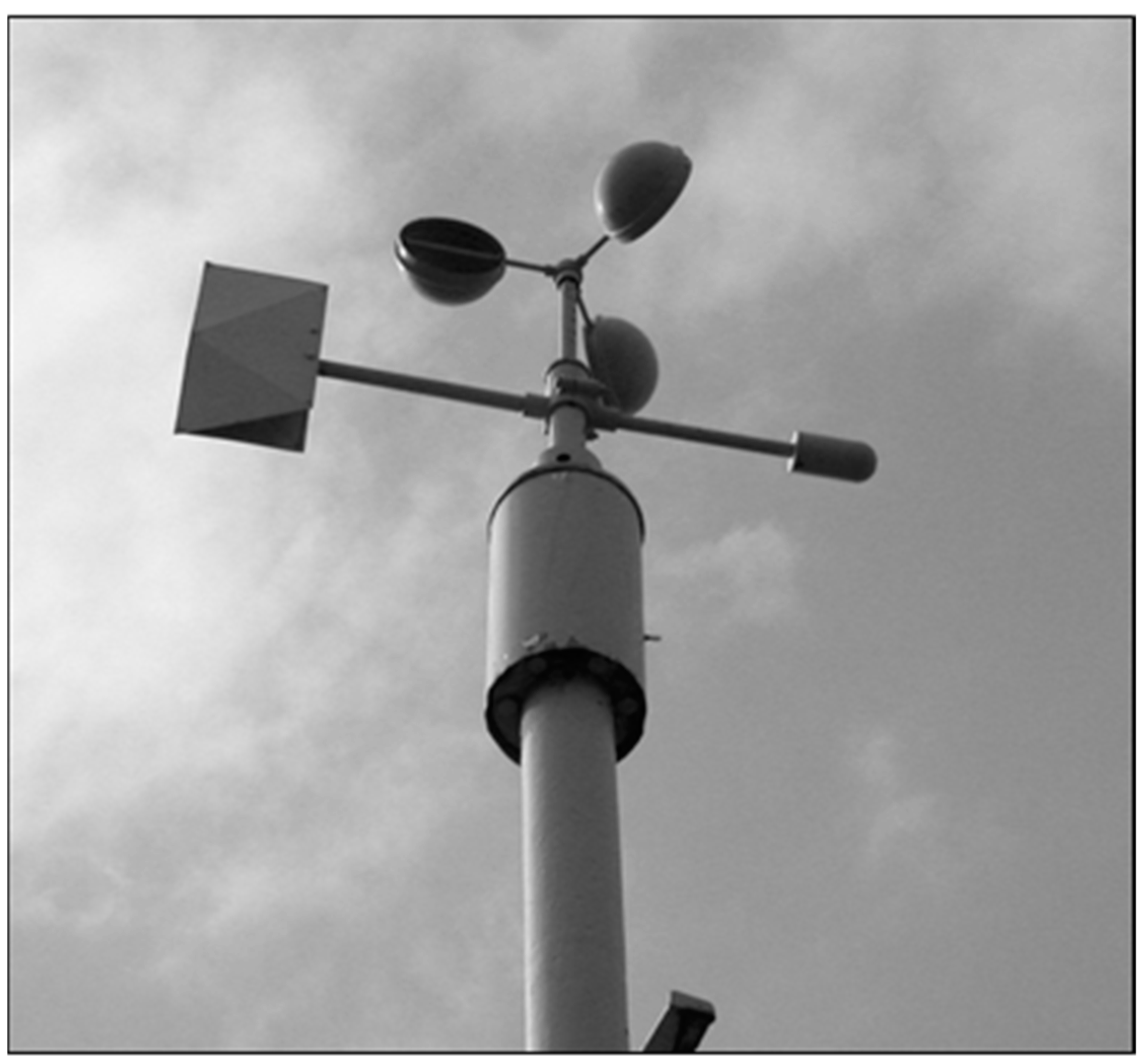
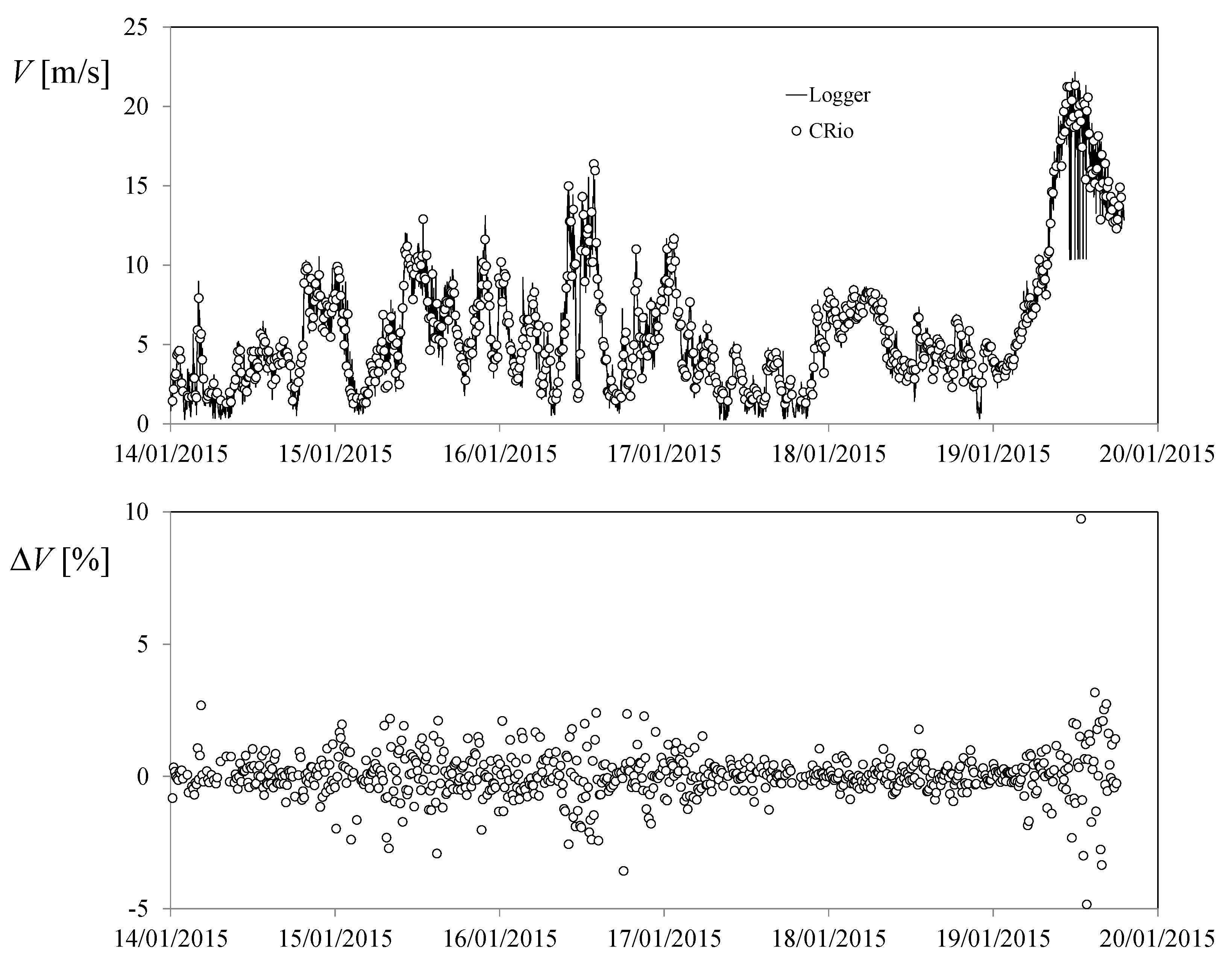
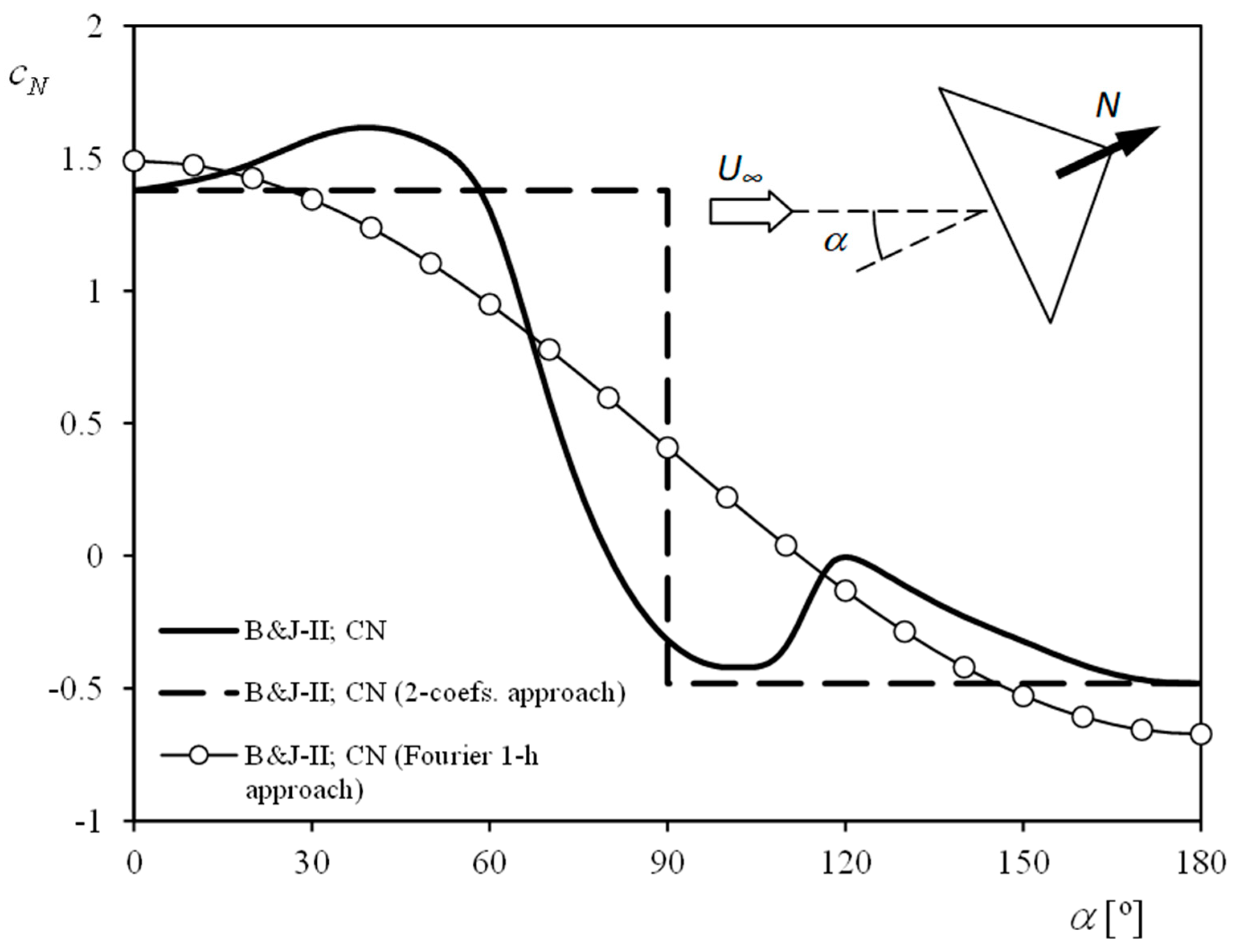

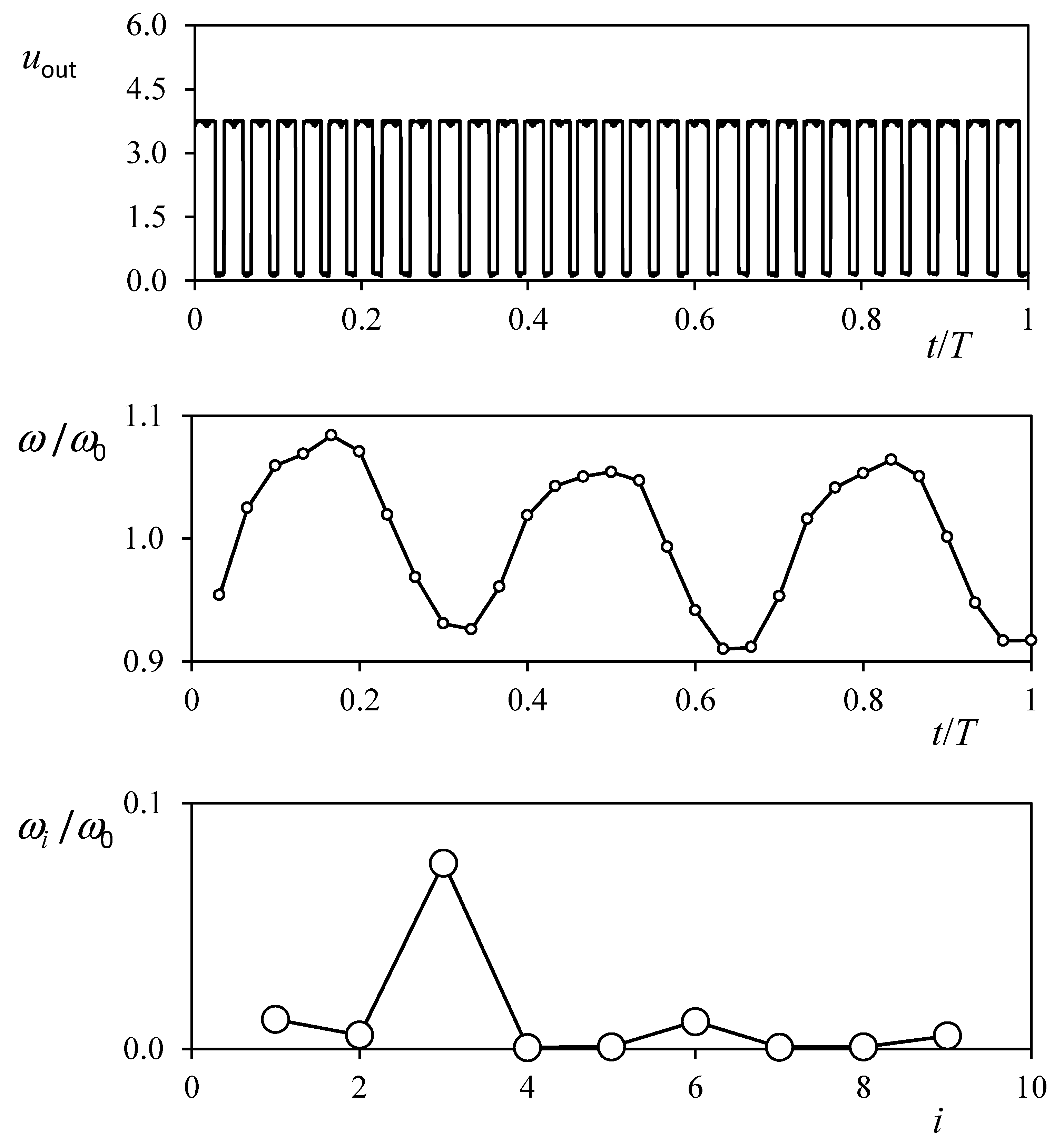
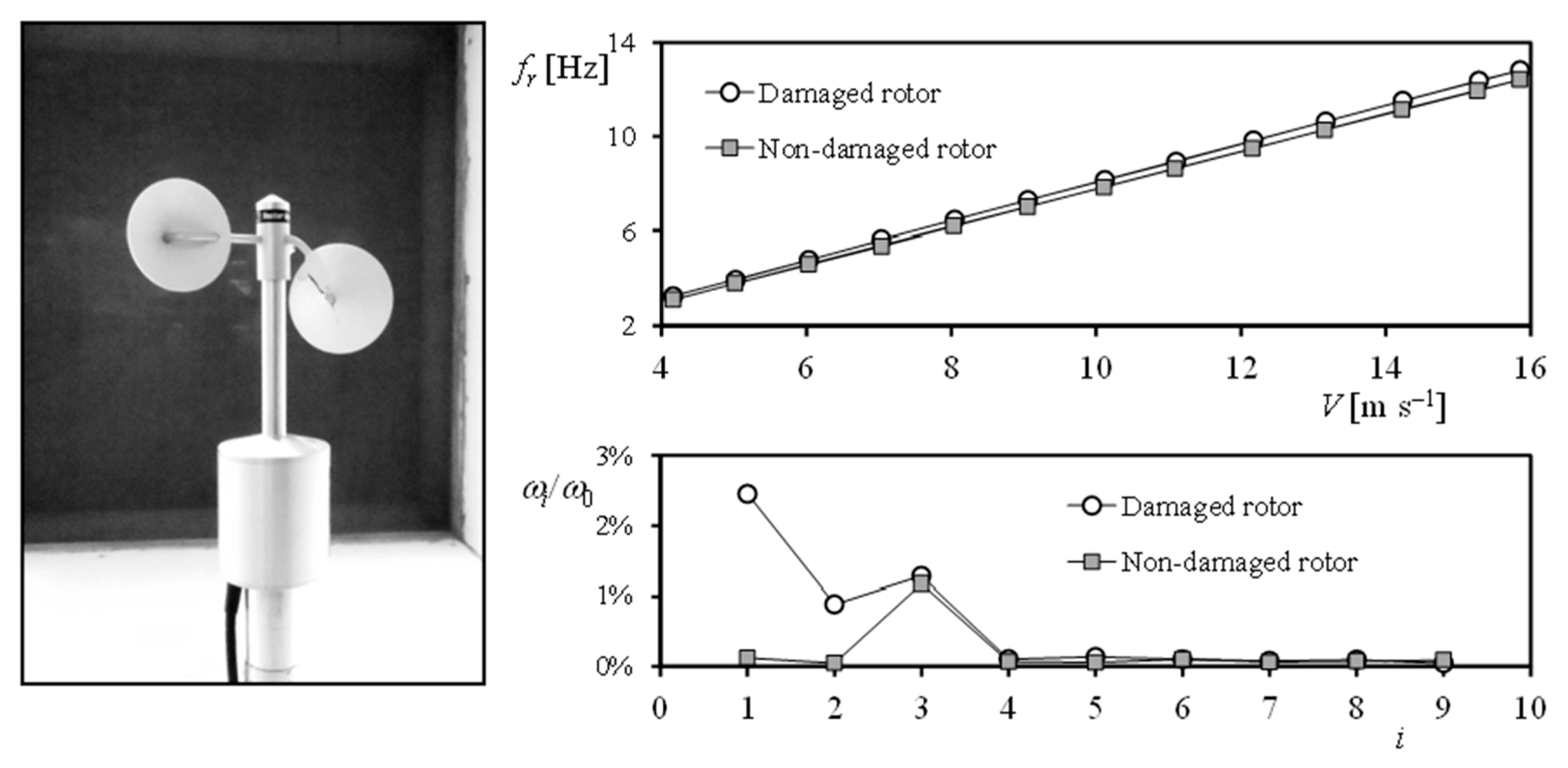
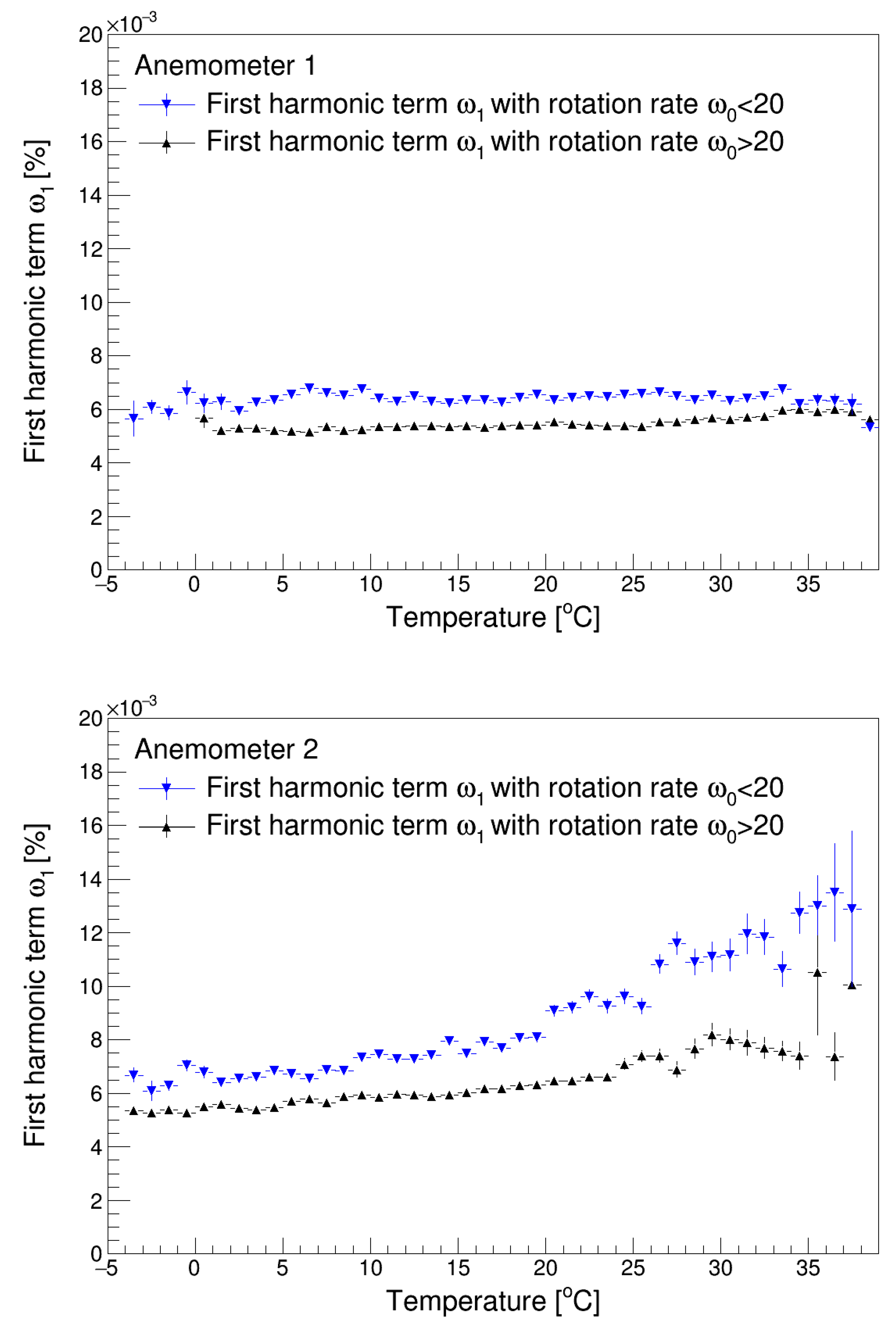
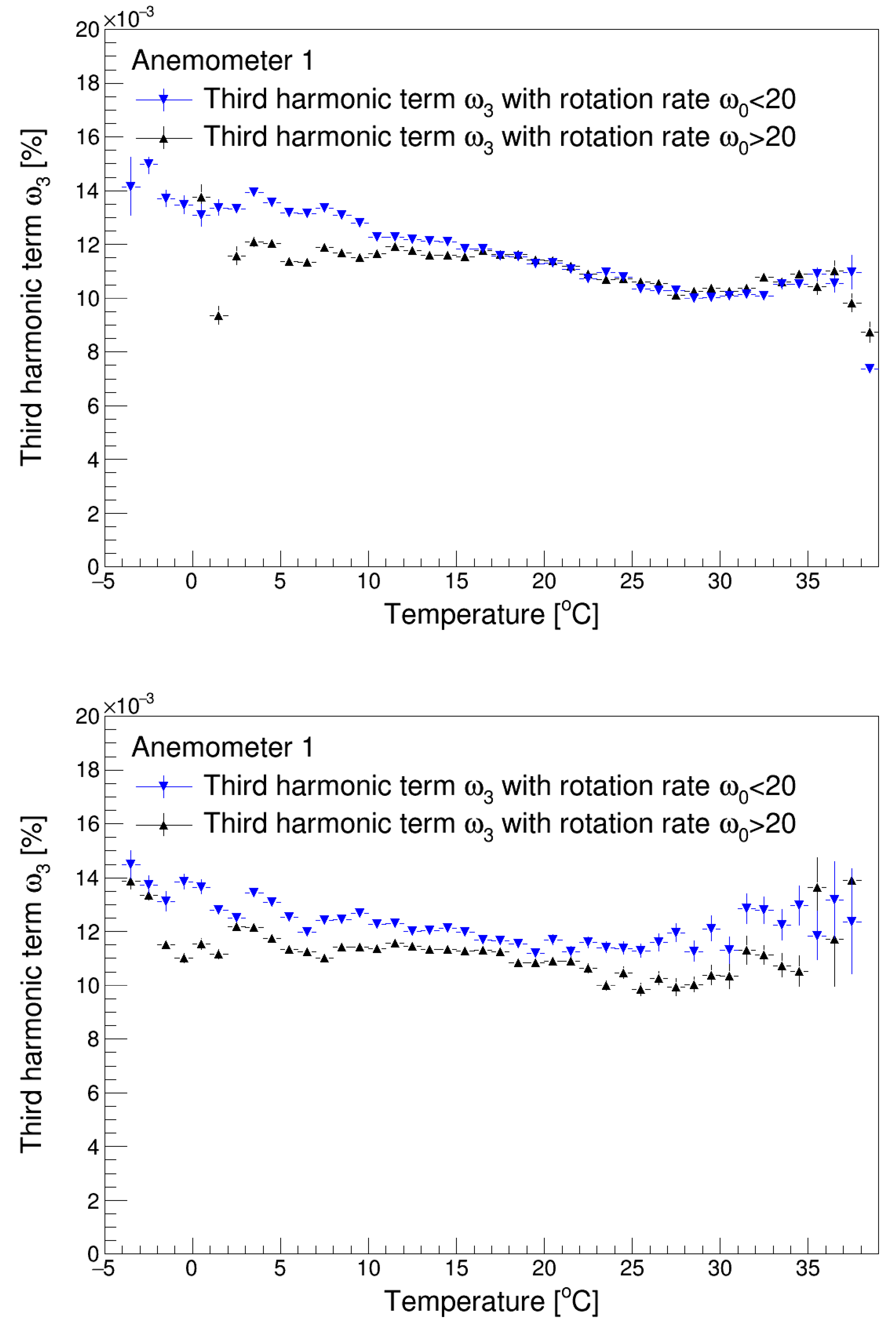
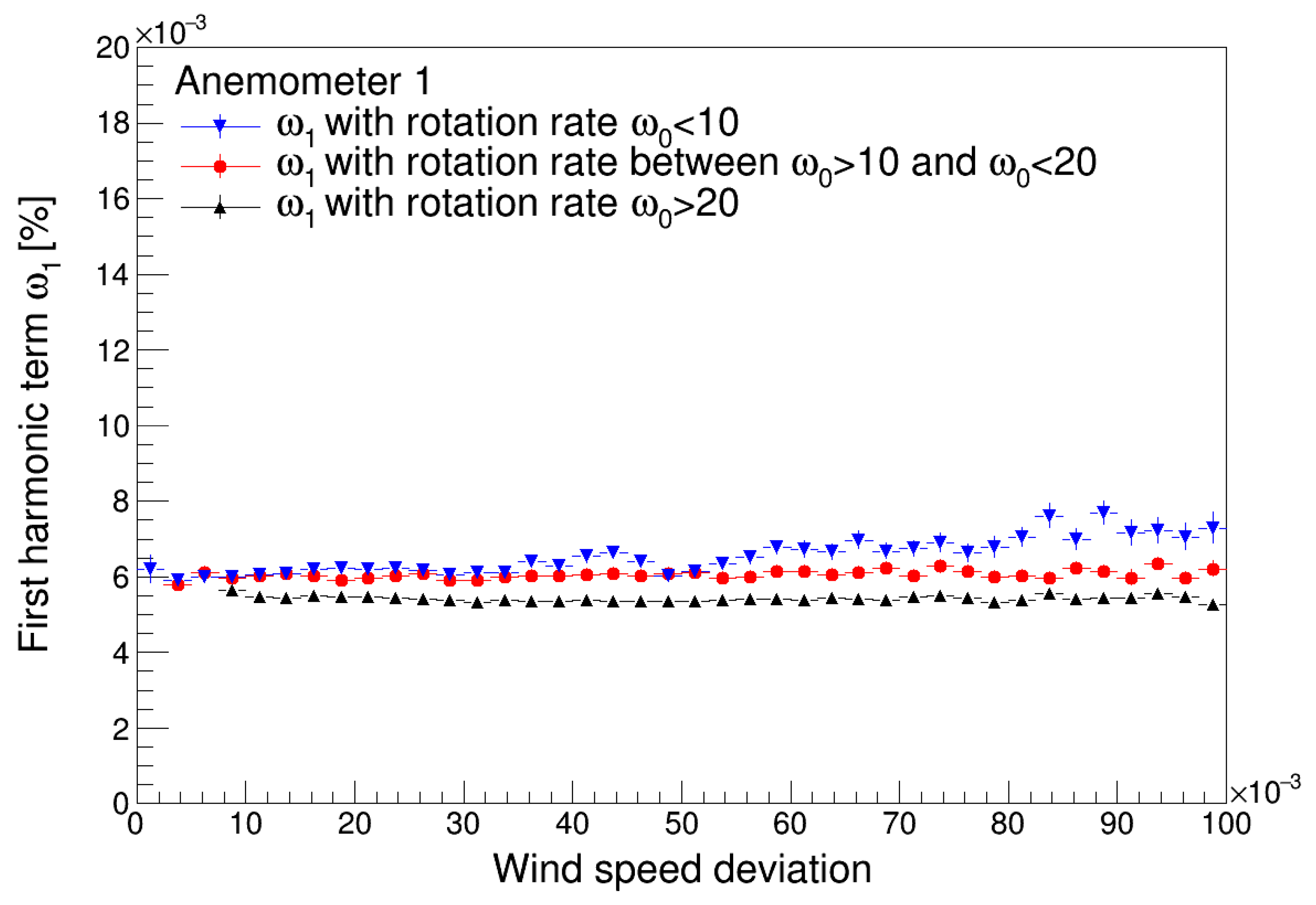

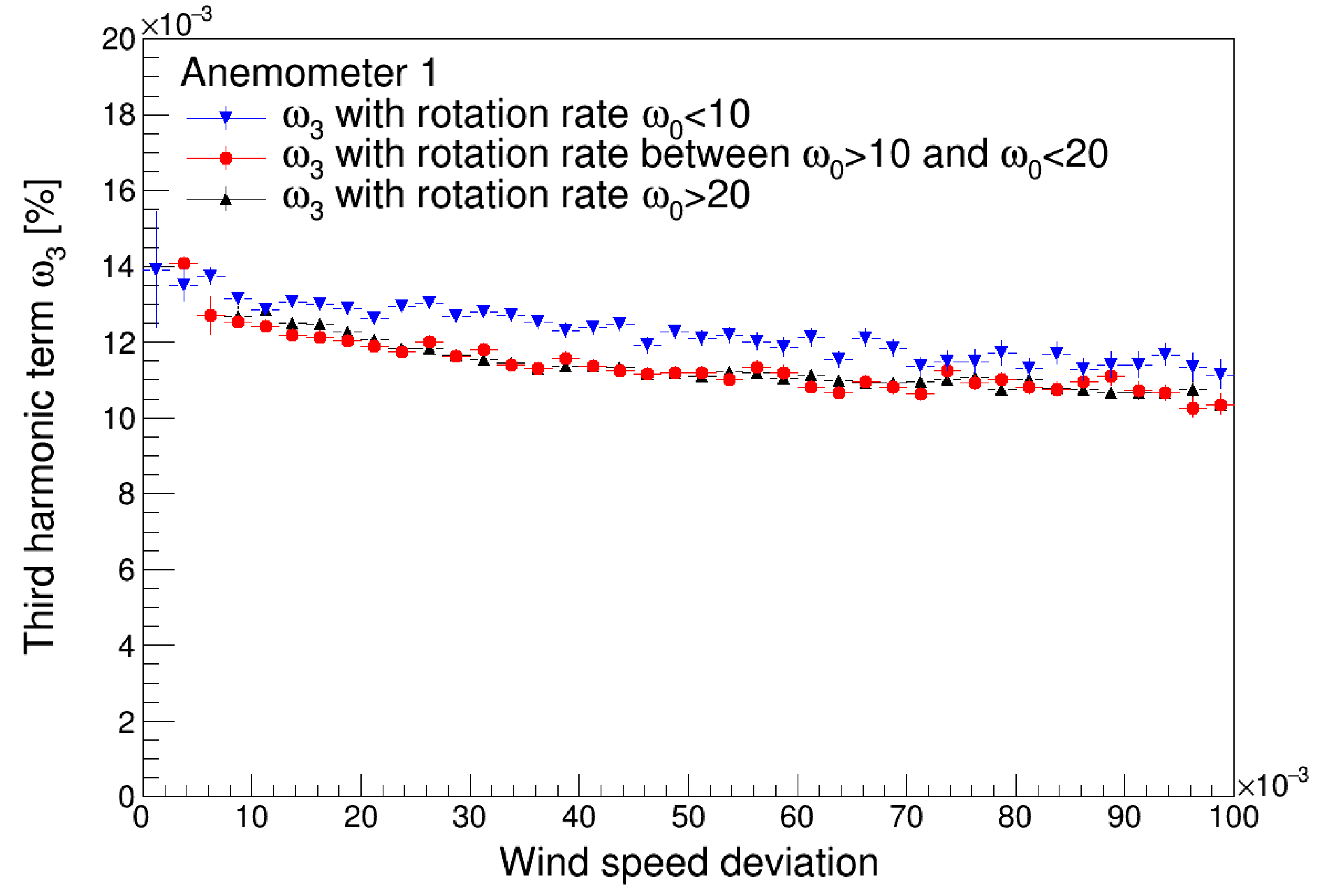
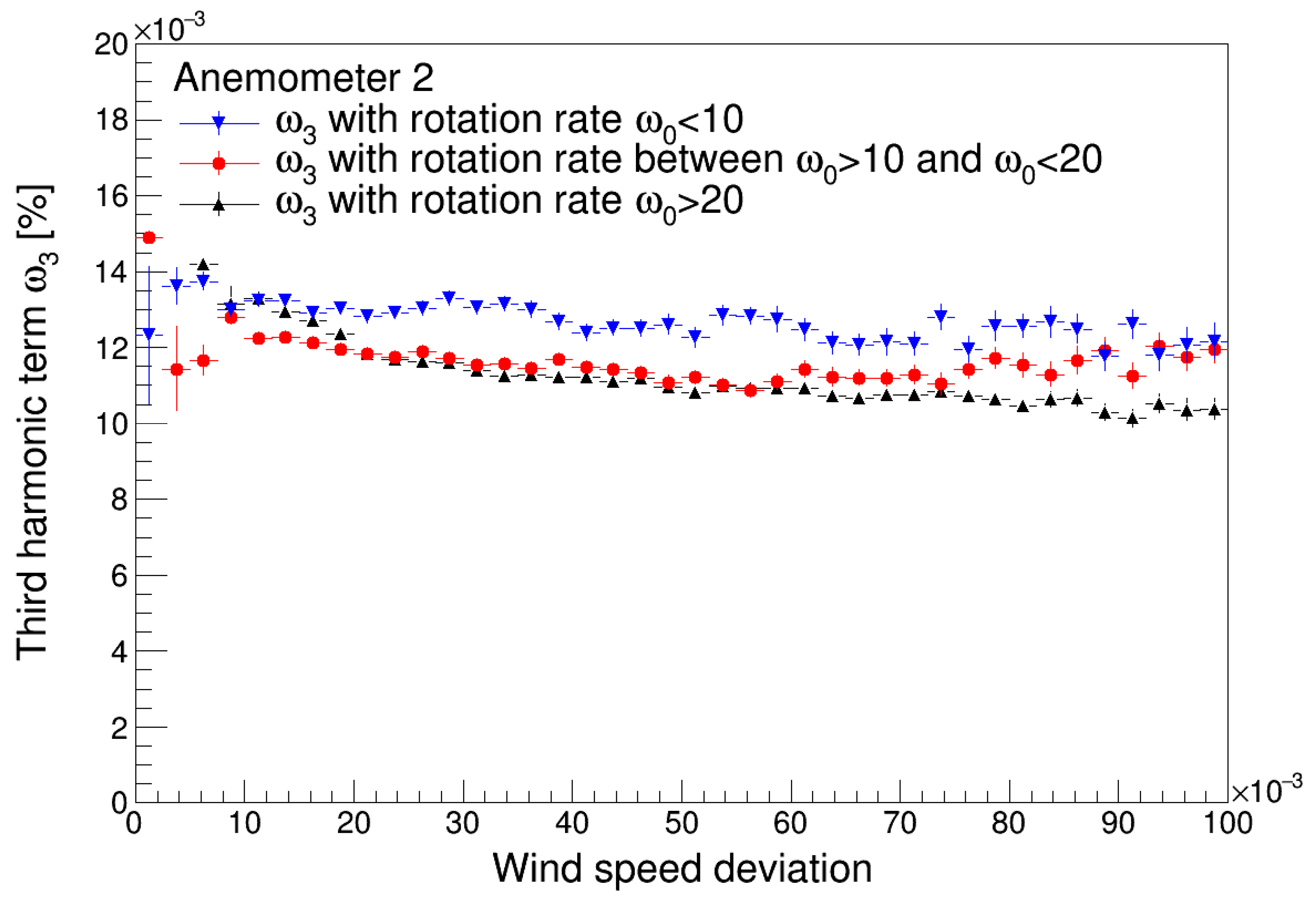

| Sensor | Date | A (m) | B (m/s) |
|---|---|---|---|
| Anemometer 1 | 19 January 2015 | 4.6054499·10−2 | 0.26775189 |
| Anemometer 2 | 14 November 2014 | 4.6201745·10−2 | 0.24465440 |
| Anemometer 2 | 15 July 2016 | 4.6222883·10−2 | 0.26985310 |
Publisher’s Note: MDPI stays neutral with regard to jurisdictional claims in published maps and institutional affiliations. |
© 2022 by the authors. Licensee MDPI, Basel, Switzerland. This article is an open access article distributed under the terms and conditions of the Creative Commons Attribution (CC BY) license (https://creativecommons.org/licenses/by/4.0/).
Share and Cite
Mangano, S.; Vega, E.; Martínez, A.; Alfonso-Corcuera, D.; Sanz-Andrés, Á.; Pindado, S. Performance Monitoring of Mast-Mounted Cup Anemometers Multivariate Analysis with ROOT. Sensors 2022, 22, 9774. https://doi.org/10.3390/s22249774
Mangano S, Vega E, Martínez A, Alfonso-Corcuera D, Sanz-Andrés Á, Pindado S. Performance Monitoring of Mast-Mounted Cup Anemometers Multivariate Analysis with ROOT. Sensors. 2022; 22(24):9774. https://doi.org/10.3390/s22249774
Chicago/Turabian StyleMangano, Salvatore, Enrique Vega, Alejandro Martínez, Daniel Alfonso-Corcuera, Ángel Sanz-Andrés, and Santiago Pindado. 2022. "Performance Monitoring of Mast-Mounted Cup Anemometers Multivariate Analysis with ROOT" Sensors 22, no. 24: 9774. https://doi.org/10.3390/s22249774







